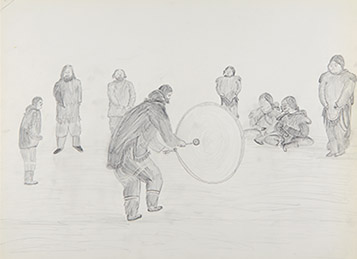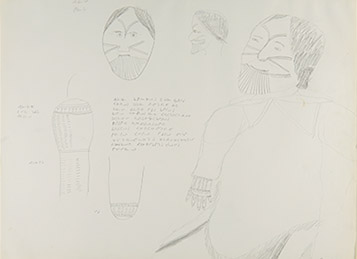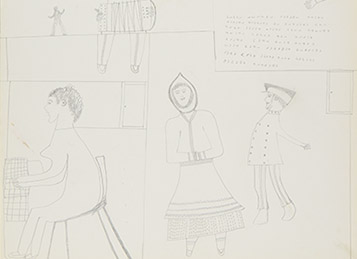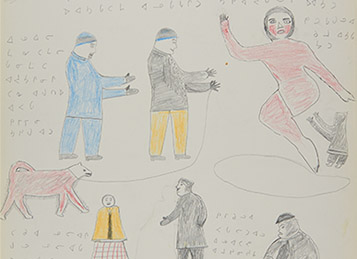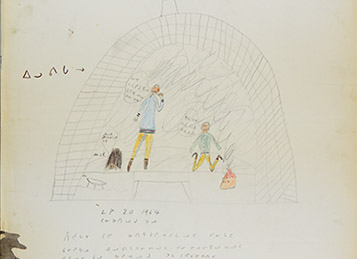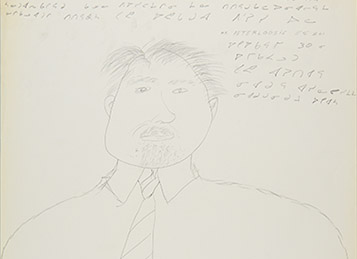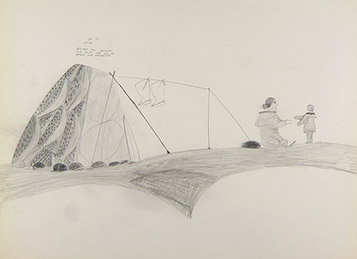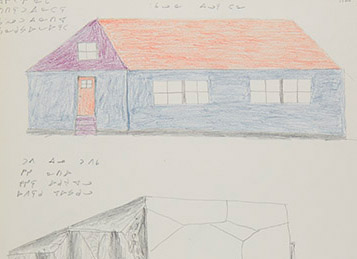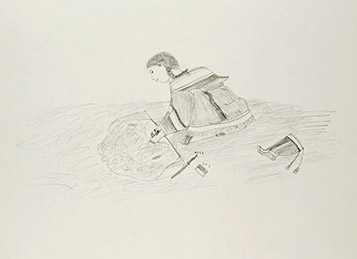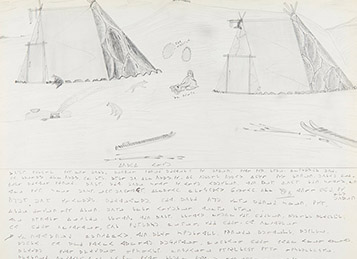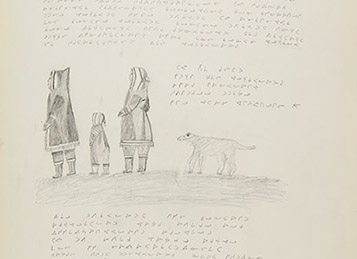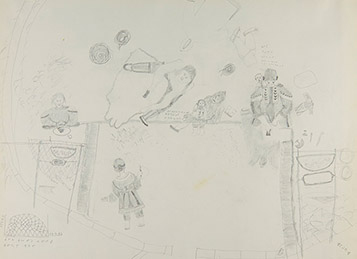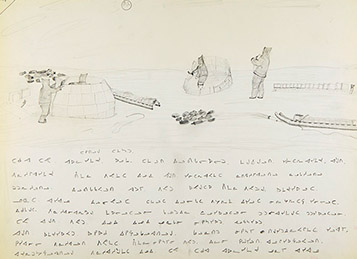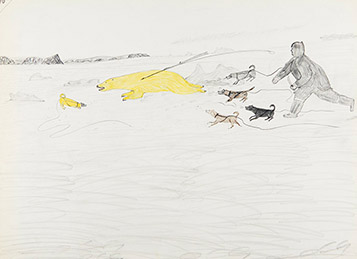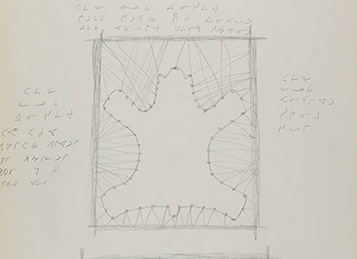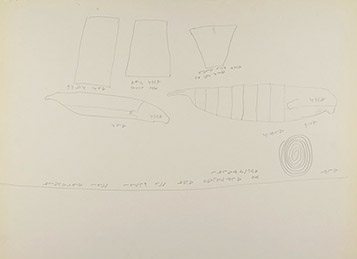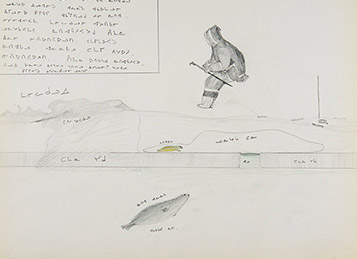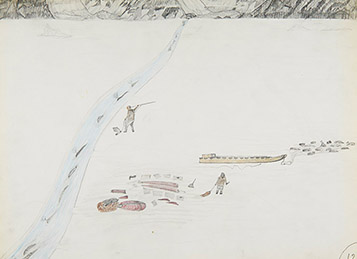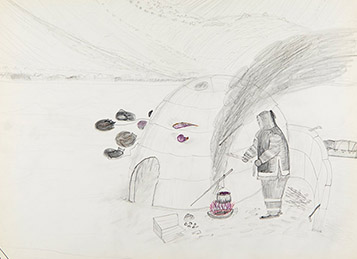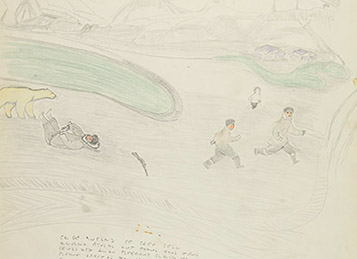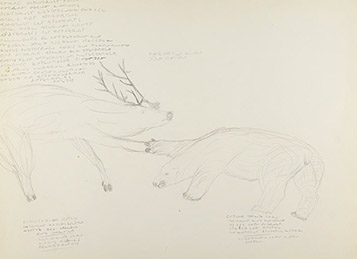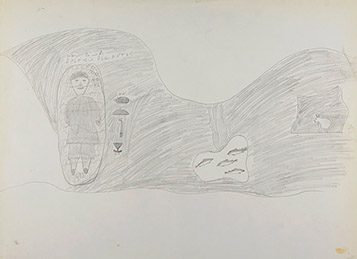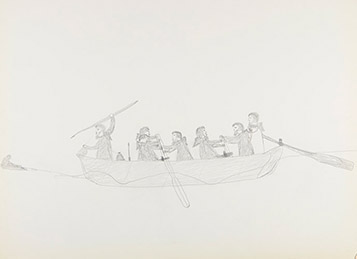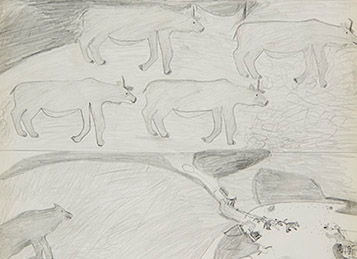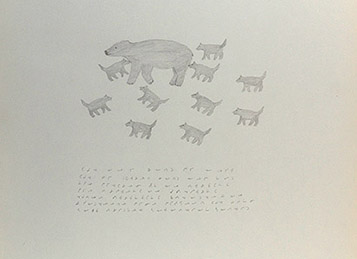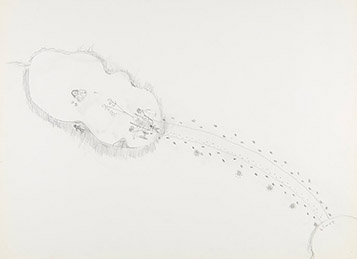Conveying Identities
Inuit had their own way of doing things, like playing games like arm wrestling. The way we were taught about traditional life was not just about hard work, but there were games and drum dances when there was plenty of food.
Ham Kadloo, 2016 (Pond Inlet)
On the Land
When I think about my ancestors during those old times, when there were no stores, and no people were living here [in town], everyone was living in camps and they were able to survive. I am very thankful for those people that were able to survive on nothing – just on land, just on tools. And their knowledge, because if they didn't survive we wouldn't be here.
Gamaili Kilukishak, 2016 (Pond Inlet)
Our Stories
It's my role, it seems, to talk about life back then or to tell the stories that my late dad told me. Those kinds of stories my dad gave me, I try to give to others. I feel it's up to us, the older generation, that we still have to talk about them, even though we might not use them, but at least the knowledge, so it's there.
Joanna Kunnuk, 2016 (Pond Inlet)

Jemima Angelik
Nutarak Pond Inlet NU 1915
String Games and Ayagaq
1964
Graphite on paper
Canadian Museum of History
IV-C-7691
This drawing documents different cat's cradle patterns and an Inuit "cup and ball" style game (ayagaq), which is being played inside the igloo. The artist lists the different string game patterns, such as "kayak" and "fox trap," and adds several more on the back. These games were a way to tell stories and convey life lessons with humour and joy.
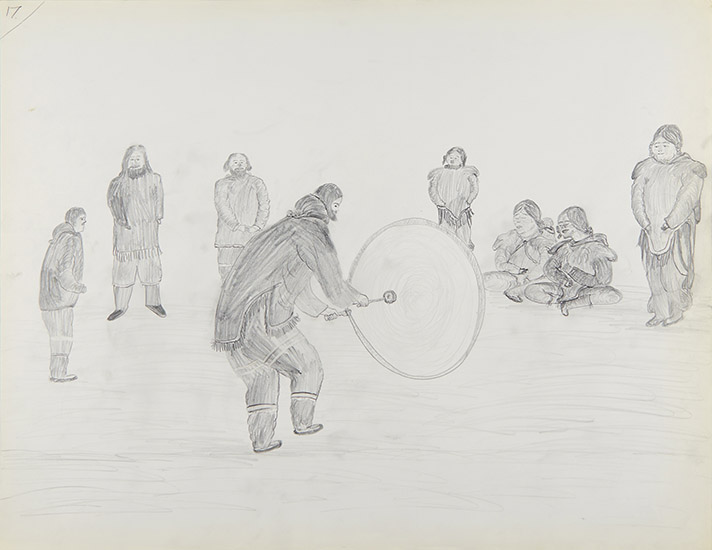
Cornelius (Kooneeloosee) Nutarak
Clyde River NU 1924–2007 Pond Inlet NU
Celebration and Drum Dancing
1964
Graphite on paper
Canadian Museum of History
IV-C-6955
Inscription on back: "Just like they did in very old times, he is dancing. They are also singing. The women are singing 'Ayaya, Ovanga, Oya, Ayaya.' The person dancing is saying 'Eya'."

Jemima Angelik Nutarak
Pond Inlet NU 1915
Juggling Songs
1964
Graphite on paper
Canadian Museum of History
IV-C-6917
This woman, dressed in a fine caribou skin amauti, juggles stones and sings an Ajaja song about her world, using words that are ancient with obscure or nonsensical meanings:
"...who are your uncles,
Singing Ajaja
Tools,
Through the needle,
Whip, pointed ones,
Singing Ajaja…"

Jemima Angelik Nutarak
Pond Inlet NU 1915
Things Left for Us from the Old Times
1964
Graphite on paper
Canadian Museum of History
IV-C-6839
Inscription on reverse: "These people are looking for things of the Tuniit (Dorset people). They found the objects they owned; birdlike objects we used as toys or playthings, old-style ulus, old-style needles, pots. We found many old objects. …I have many stories and legends about the Tuniit."

Jemima Angelik Nutarak
Pond Inlet NU 1915
Amautik Patterns and Regional Styles
1964
Graphite on paper
Canadian Museum of History
IV-C-6931
With meticulous accuracy, this artist draws and names all the different components of a caribou skin amautik (woman's hooded parka), with accompanying leggings and kamik (boots). Patterns were never made in advance: all the pieces seen here would have been memorized and cut to size without the use of a measuring tape—a tremendous technical and intellectual undertaking.
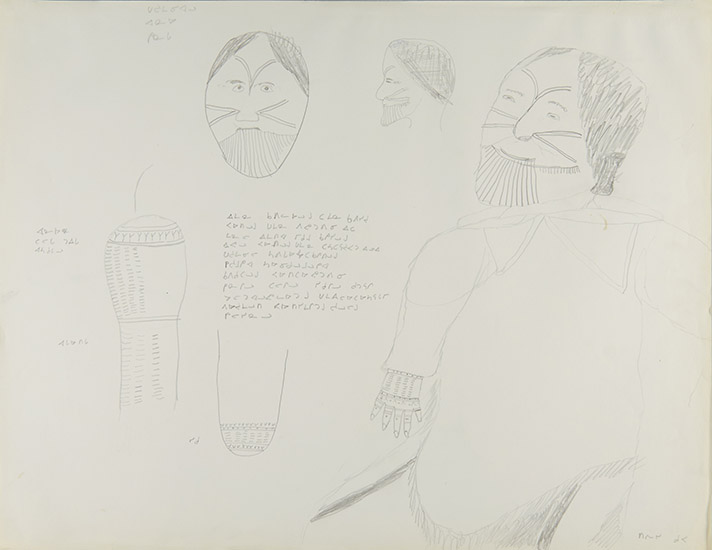
Therese Maktar
Pond Inlet NU 1930–2013 Pond Inlet NU
Women's Tattoos
1964
Graphite on paper
Canadian Museum of History
IV-C-8239
Inscription: "This is the way they pierced the skin and then spread soot into the area they poked. This is how they did a long time ago. They used a needle and thread darkened with soot. That is what Inuit tattooed themselves with. But before they had metal, maybe they would use a small bone to pierce the skin."

No video available
Therese Maktar
Pond Inlet NU 1930–2013 Pond Inlet NU
Traditional Arm Wrestling
1964
Graphite on paper
Canadian Museum of History
IV-C-6880
"These two men are testing their strength"
A competitive test of strength, Inuit arm wrestling was much like European arm wrestling, but it was played seated on the ground with legs interlocked.

Solomonie Tigullaraq
Clyde River NU 1924–2000 Clyde River NU
New Things in Our Life
1964
Graphite on paper
Canadian Museum of History
IV-C-7664
Several drawings document interest and pride in "new" things in people's lives. The inscription reads: "The shovel, a pick; a box for primer and stove; a woman; a man is playing his accordion. They are inside the house, and there is a little child standing on the side playing an organ. There is also a woman watching the show and a policeman is just coming inside..."

Anna Ikkirat Paipuq
Clyde River NU 1906–1974 Clyde River NU
Strange Scene
1964
Graphite on paper
Canadian Museum of History
IV-C-7615
Inscription (in part): "Here are men reaching to the small woman, who is bathing nude in a little pond. Her child is reaching for her.
Inuit nowadays out here are wealthy…
The husband and wife: his wife is wearing a cape, and her husband is beside a shadow…"

Josie Enuaraq
Clyde River NU 1942
Stinky Iglu
1964
Graphite on paper
Canadian Museum of History
IV-C-8055
Inscription: "At the time we were out seal hunting near the floe edge, we were in our iglu and we were getting ready for bed. Kalluk was burning gas inside a tobacco can which made us stink and we were running low on gasoline. Our Coleman stove was no longer lit and it became cold."
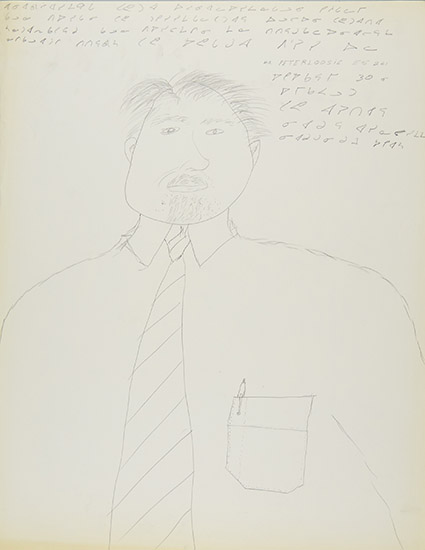
Peter Paneak
Clyde River NU 1934
The Time I Banged My Head
1964
Graphite on paper
Canadian Museum of History
IV-C-7590
Inscription: "I went to a hospital and that's all. I have never gone to school to learn White-man's way, the only western trade I know is construction, that's the only one I've ever been employed in. I will draw here but I won't draw on the entire sheet. This is me, Peterloosie, E5-261, I'm 30 years old. I have a beard and moustache. This looks like me but my head has changed because of bad headaches last fall."

Imaruituq Taqtu
Arctic Bay NU 1934
What We Did to Make a Sealskin Tent
1964
Graphite on paper
Canadian Museum of History
IV-C-6735
Inscription: "Here is the tent. It is exactly the same [as is shown]. A long time ago they used tents like this. The white part is the skin side; the seal skin was split into two parts by cutting in between the fur side and the skin side as you can see in the drawing.."
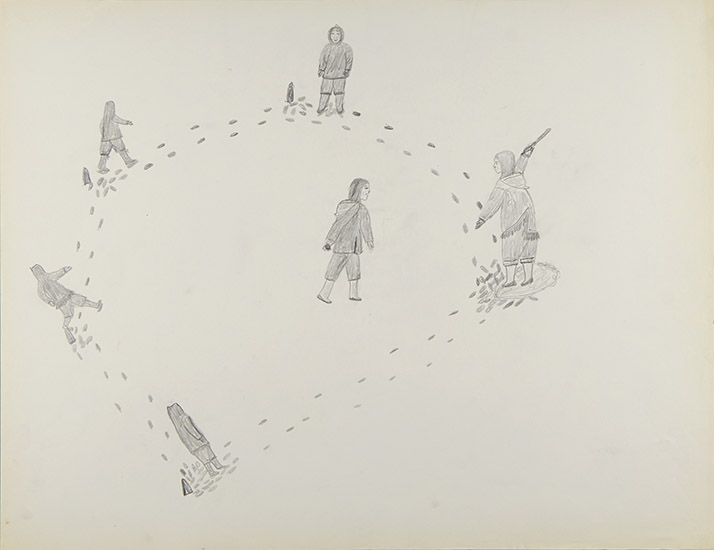
Jemima Angelik Nutarak
Pond Inlet NU 1915
Inuit Baseball
1964
Graphite on paper
Canadian Museum of History
IV-C-6919
Inscription on back: "These people are happy playing baseball … Here is a picture of a man batting. Once he hits the ball, he starts running as fast as he can. … Inuit used to have different sports. There are bases; the bat is made of antler or wood. They also have a ball, sewn up with sand or skins inside."
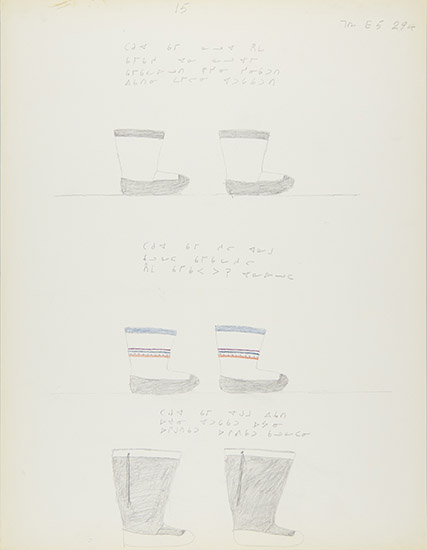
Mary Tassugat
Clyde River NU 1918–2016 Clyde River NU
Boot Styles I Make
1964
Graphite on paper
Canadian Museum of History
IV-C-7545
Inscription on top: "These are kamiks [boots]. The women wear these made from bleached hide and part of it is bleached fur for the trim, with dried and stretched hide for the soles.
middle: These boots are still women's kamiks, and they have waterproof fabric. These are the type of boots we women wear.
bottom: …These boots are for men."
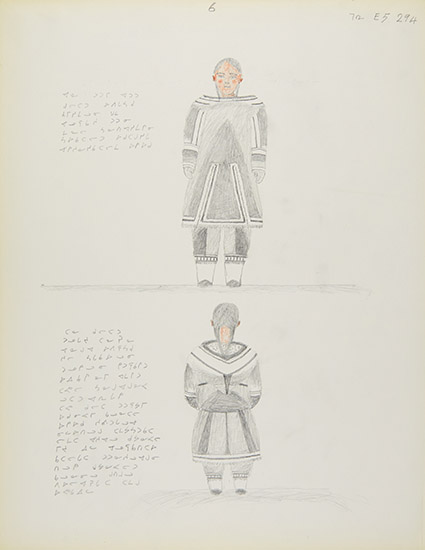
Mary Tassugat
Clyde River NU 1918–2016 Clyde River NU
This Is How They Made Clothing for the Winter
1964
Graphite on paper
Canadian Museum of History
IV-C-8229
Inscription: "The woman is wearing a caribou skin outfit called "qulittaq". It is springtime so she is wearing these boots. This type of caribou skin clothes is not properly made any more. Nowadays they are made very well … We appreciate now that we have more clothing selections. They are not caribou hunting very much any longer for clothing…"
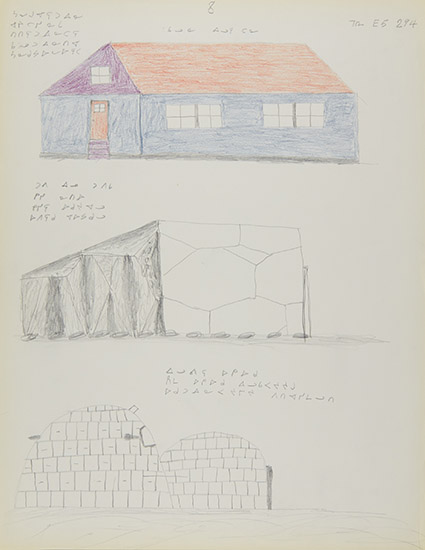
Mary Tassugat
Clyde River NU 1918–2016 Clyde River NU
Different Homes We've Had
1964
Graphite on paper
Canadian Museum of History
IV-C-7511
Inscription: "I drew this without copying any particular house, [but] just as I want to draw it because we were asked to draw. This is a Qalunaaq's house [top]. This is an Inuit tent [middle]. It is made of sealskins and harp seal skins and used during the spring and summer. This [bottom] is an iglu used during winter. It was warm when it was built right."

Martha Coronik Akoomalik
Pond Inlet NU 1912–2002 Pond Inlet NU
How to Scrape Sealskin
1964
Graphite on paper
Canadian Museum of History
IV-C-6869
Inscription: "This is how I used to skin. My clothes are made of caribou skins. … This is me preparing a skin. This is baby sealskin. I am cleaning the skin and I scrape it. I also wash it, scrape it again, then I hang it to dry using pegs. When it dries, I wash the excess fat and soften it, then wash it again. You can make it soft, then cut it to patterns for clothing or boots."
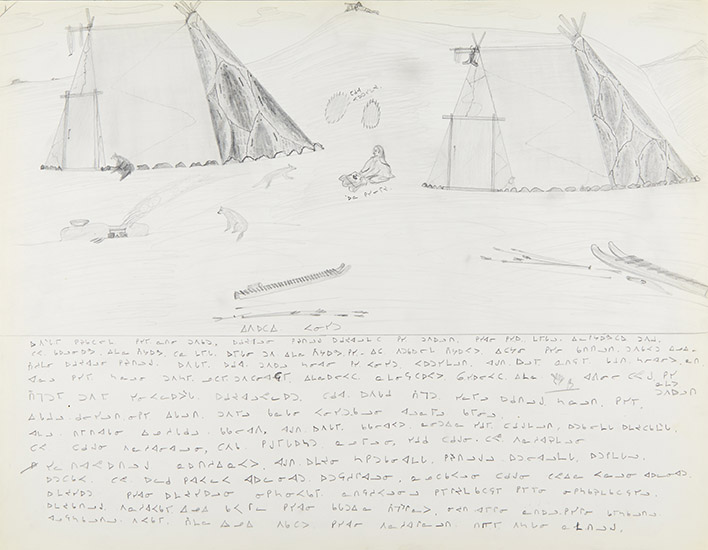
No video available
Cornelius (Kooneeloosee) Nutarak
Clyde River NU 1924–2007 Pond Inlet NU
Preparing Sealskins
1964
Graphite on paper
Canadian Museum of History
IV-C-6945
Inscription: "1) These are drying skins; 2) She is skinning sealskins; 3) The (dog) harnesses are drying. The woman is skinning a hide. She is making it so she can have a new tent. If they say it should look like this and is perfect, you have enough skins. If there are six skins it should be enough for a tent. I used to sleep in this type of tent and it got very hot inside…"
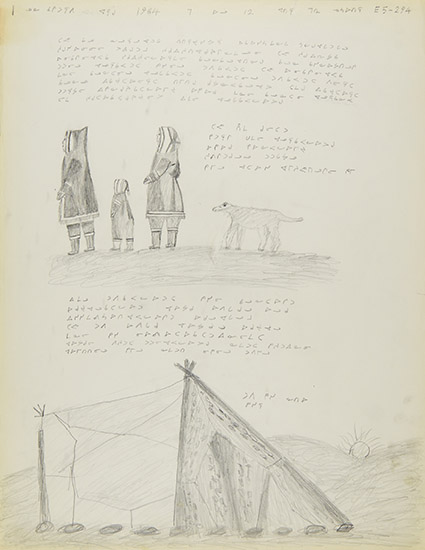
Mary Tassugat
Clyde River NU 1918–2016 Clyde River NU
The Many Uses of Sealskin
1964
Graphite on paper
Canadian Museum of History
IV-C-7534
Inscription: "…Here is a man's caribou skin parka [Qulittaq]. Their children wore these, one piece. It used to get cold in wintertime. This [picture] shows one dog from the many they had.
This is how we had our tents. The non-canvas ones [sealskin] would get hot inside, during spring and summer at night. Sometimes it would get too hot to be inside …Today, they get skins only to sell them."
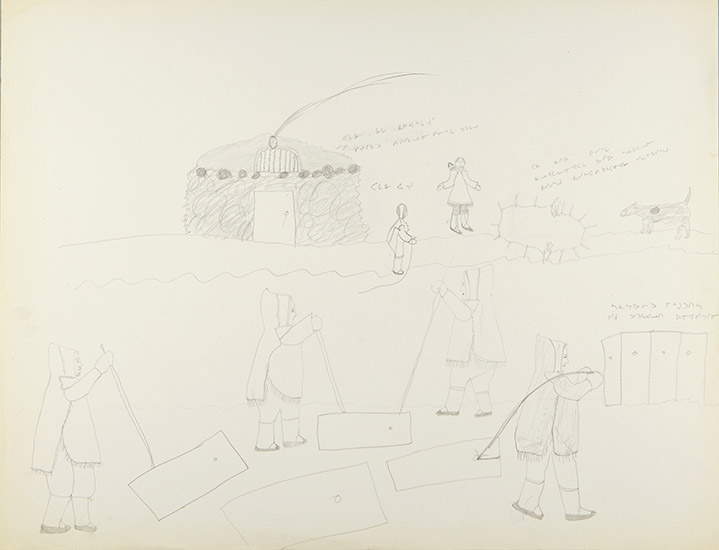
Angootainook Katsak
Pond Inlet NU 1932
Making Shelters Using Ice Blocks
1964
Graphite on paper
Canadian Museum of History
IV-C-7163
Inscription on top: "This [structure] has a wood addition on the top and back of the building. The wood is supporting the rocks that are piled up around it. This part [lower] is soil.
Inscription on bottom: "They are now building a freezer. These ice blocks have holes so they can move them."
Inscription on reverse: "…Once they finish building this ice box, they will fill it up with cached caribou meat, and they also eat after they are all done working…"

Lydia Atagootak
Pond Inlet NU 1913
Women's Responsibilities Then and Now
1964
Graphite on paper
Canadian Museum of History
IV-C-8202
The inscription on the back of this drawing describes the long hours of daily work being done by each family member, with a particular emphasis upon the laborious work of women to clean, prepare and sew caribou hide: "A long time ago the women would work with precision; their husbands would help…Those of you seeing my drawings, farewell to all of you. I am smiling at you if you are reading this."
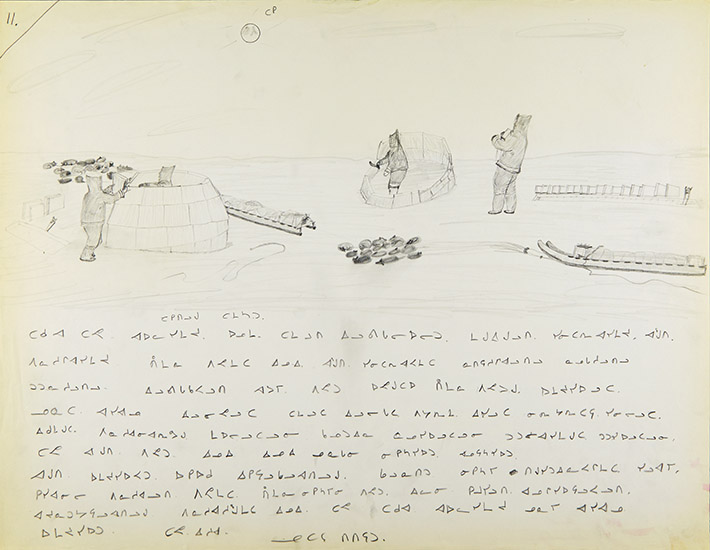
Cornelius (Kooneeloosee) Nutarak
Clyde River NU 1924–2007 Pond Inlet NU
Making Igloo Together
1964
Graphite on paper
Canadian Museum of History
IV-C-6953
Inscription: "In this drawing, they are out on the land. It is night-time. They are setting up their temporary camp, building an iglu, two hunting parties. They are staying the night out on the land hunting. That is how they did it… They do not just go to the shed and pick their dinner like White people. They have no choice but to hunt for it…"
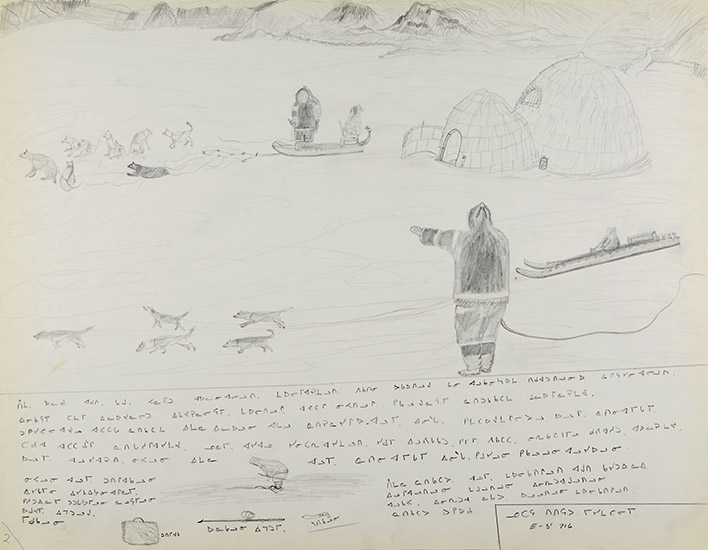
Cornelius (Kooneeloosee) Nutarak
Clyde River NU 1924–2007 Pond Inlet NU
Seal Hunting
1964
Graphite on paper
Canadian Museum of History
IV-C-6946
Inscription: "Once, there were two men who just finished packing and were ready to leave. They wanted to go seal hunting on the ice, when one man pointed and said, 'There are more seal in that direction…'" Continued on back: "…It is so much fun seal hunting on ice. That is how we do it because our ancestors did it, and we are just following them. Our fathers did the same thing. We would leave with our fathers and learn from them about hunting…"
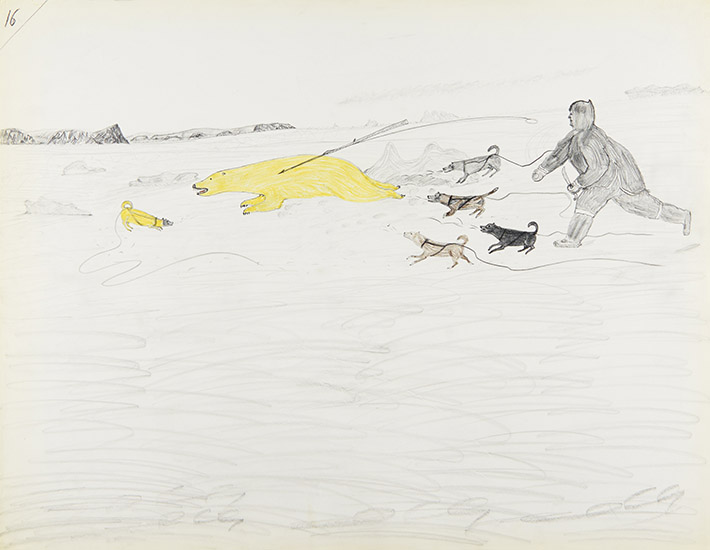
Cornelius (Kooneeloosee) Nutarak
Clyde River NU 1924–2007 Pond Inlet NU
Hunting Polar Bears with Dogs
1964
Graphite on paper
Canadian Museum of History
IV-C-6954
Inscription on reverse: "Elders would do this a long time ago. They would catch polar bears with spears and sometimes with knives…The dogs would keep the bear occupied so it wouldn't attack a person. The person would then throw a spear at it, and it would eventually die. Sometimes they used a knife to kill a polar bear, attracting it to come close then stabbing it when it attacked. Today, I never hear of anyone hunting a polar bear with a knife."

Mary Tassugat
Clyde River NU 1918–2016 Clyde River NU
Stretching Skins to Use
1964
Graphite on paper
Canadian Museum of History
IV-C-7533
Inscription: "This is how we stretch skins during springtime to dry. My children and their children will dry polar bear skins like this, or perhaps not any more. This is a polar bear skin that has been stretched. I hung it on May 18th and removed it on the 20th in 1964. This polar bear skin is hanging outside facing the sun so it can dry. This [below] is a sealskin hanging to dry."

Therese Maktar
Pond Inlet NU 1930–2013 Pond Inlet NU
Making Rope from Seal
1964
Graphite on paper
Canadian Museum of History
IV-C-6873
The artist indicates which parts of the thick sealskin are used for making rope, and which parts are used for making boot soles. The inscription reads: "Men use bearded seal hide to make ropes, harnesses, sleds, front of boots, and boot soles. The front side of the bearded seal, just above the nose to the back, is for the back sides of boots, the sides of the seal for harness."

No video available
Cornelius (Kooneeloosee) Nutarak
Clyde River NU 1924–2007 Pond Inlet NU
Catching Seal Pups
1964
Graphite on paper
Canadian Museum of History
IV-C-6847
Inscription (in part): "This man is trying to catch a seal. He sees the seal's chamber. He jumps. He caves in the chamber with the pup…the mother is underwater. He hooks the seal pup before it dives…and he catches both by using the pup to lure the mother to the hole…"
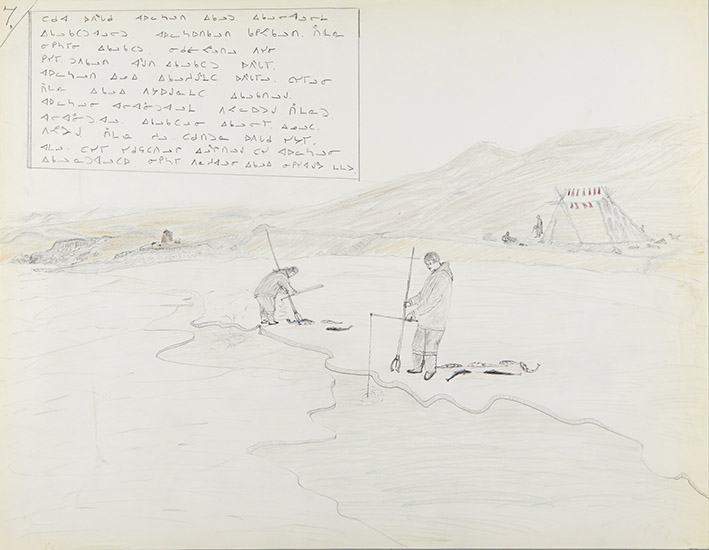
Cornelius (Kooneeloosee) Nutarak
Clyde River NU 1924–2007 Pond Inlet NU
Fishing at a Crack in the Ice
1964
Graphite on paper
Canadian Museum of History
IV-C-6949
The artist depicts spring fishing at a crack in the ice using jigs and fish spears. The inscription conveys the pleasure of fishing: "That was how we caught fish back then. It was very exciting when we caught fish… That is how we are still doing it, just like you see during springtime on the shore… The fish are healthy and delicious."

Cornelius (Kooneeloosee) Nutarak
Clyde River NU 1924–2007 Pond Inlet NU
Happy Narwhal Hunting
1964
Graphite on paper
Canadian Museum of History
IV-C-8216
Inscription on reverse: "It is summertime and there is a crack in the ice. They go narwhal hunting with a harpoon. This place is called Tununiq, and it is near Pond Inlet. I remember they caught whales with only harpoons, hooks and floats. I caught a whale once at a crack in the ice. I remember it was lots of fun…"
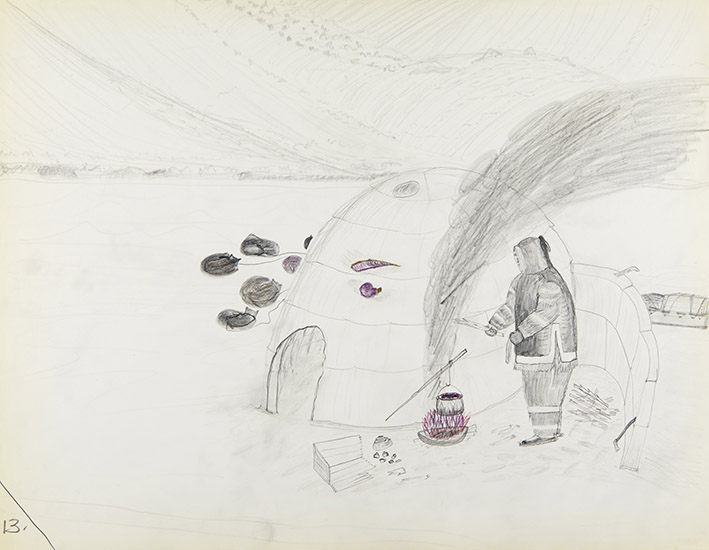
No video available
Cornelius (Kooneeloosee) Nutarak
Clyde River NU 1924–2007 Pond Inlet NU
Using Blubber to Make Fuel
1964
Graphite on paper
Canadian Museum of History
IV-C-6952
The artist, Nutarak, recalls the time when he ran out of seal oil during a hunting trip, leaving him without fuel for cooking or heating. On the back of the drawing, the artist described how he used other available resources to save his life. "I am cooking on fire because I don't have oil anymore … So I smashed up a wooden box with an axe, breaking it into pieces. Both day and night I travelled trying to get home… That is what happened to me. I remember it like it's today."

Cornelius (Kooneeloosee) Nutarak
Clyde River NU 1924–2007 Pond Inlet NU
Climbing the Cliff Face to Collect Eggs in a Teapot
1964
Graphite on paper
Canadian Museum of History
IV-C-7690
Inscription on reverse: "These are murres. Inuit would climb cliffs to get eggs and murres. The eggs taste good. The murres taste good too; they make good meat. The murres are on a cliff. They taste good but it is dangerous…"
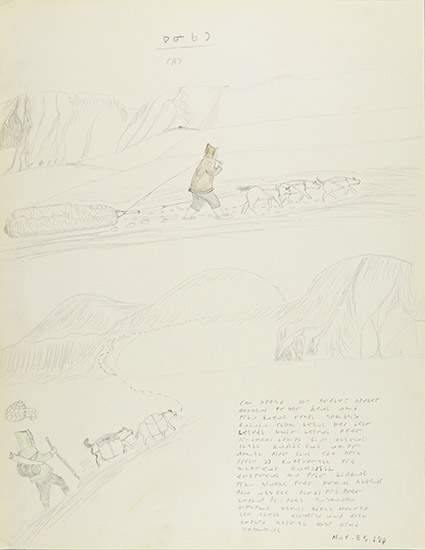
Jacob Peterloosie
Pond Inlet NU 1930
Dog Teams and Men Carrying Meat
1964
Graphite on paper
Canadian Museum of History
IV-C-6721
This image depicts when the artist got lost while searching for a food cache. The inscription reads: "When I was heading back, I knew where my tracks were and I had better navigation. I camped a couple of times because I was on the tundra where no man ever stepped. I did not want to starve to death so I was determined to get the cache that I buried during summer when we were caribou hunting by boat."
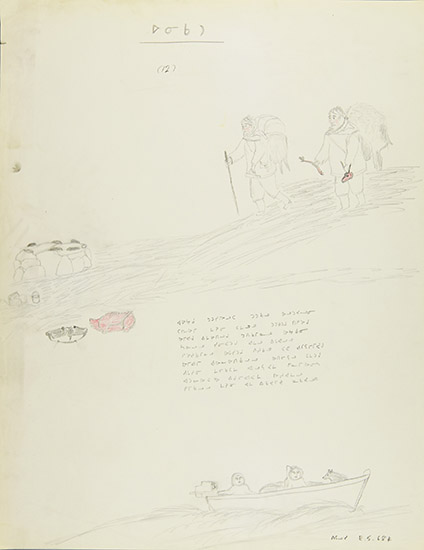
Jacob Peterloosie
Pond Inlet NU 1930
Making Shelters with Rocks
1964
Graphite on paper
Canadian Museum of History
IV-C-6722
Inscription (edited): "During summer, we hunted caribou. We caught several caribou travelling on the sea. Then we camped twice to get to the caribou grounds. When we were travelling by boat we did not have a tent so we built a shelter with big rocks. We would build fires because we did not have our Coleman stove."
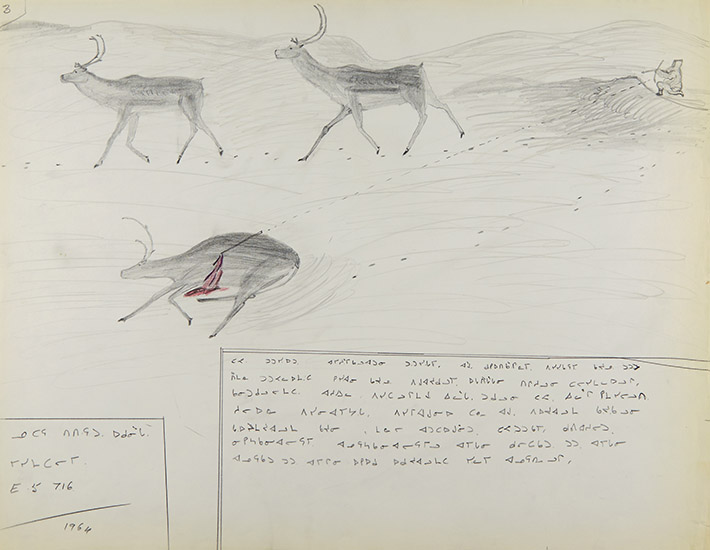
No video available
Cornelius (Kooneeloosee) Nutarak
Clyde River NU 1924–2007 Pond Inlet NU
Hunting Caribou with the Bow
1964
Graphite on paper
Canadian Museum of History
IV-C-6947
Inscription (edited and condensed): "They did not have rifles back then, so they used bow and arrow. Here, this man caught one with his arrow. That is how they used to catch caribou, only with the bow and arrow…Today, this is no longer practiced."

Jacob Peterloosie
Pond Inlet NU 1930
Tormenting a Polar Bear
1964
Graphite on paper
Canadian Museum of History
IV-C-6725
Inscription (condensed): "This picture depicts a true story… We saw a polar bear. We were on top of a hill, and he was in the water, so we threw rocks at it. He started to climb the hill so we fled. I was in such a panic and rushing, I thought there was ammunition in my rifle but I realized I had emptied it earlier. I stopped and started aiming at it, but it got too close. The polar bear pushed me and I fell backwards. Suddenly somebody shot him and it fell into the water to die."
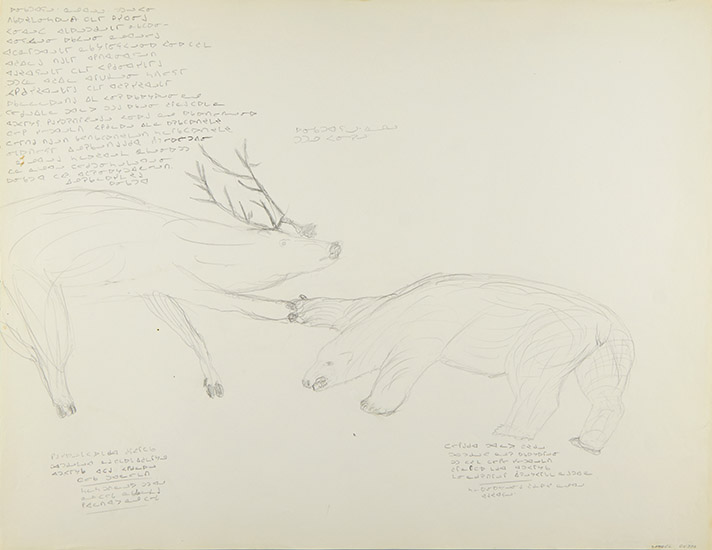
Samuel Angnetsiak
Pond Inlet NU 1942
Polar Bear and Caribou Test Strength
1964
Graphite on paper
Canadian Museum of History
IV-C-6881
Inscription (condensed): "This is a legend about a male polar bear and a male caribou competing with one another. The caribou said that he was afraid his legs would be broken. The polar bear said to the caribou that his legs were very skinny. The polar bear lost, but he broke the caribou legs… The bear and caribou were getting very intense but they both turned into humans. I did not mind these stories when I was a child. I know I have very skinny arms but I do not mind."

Lazaroosie Kyak
Button Point NU 1919–1976 Pond Inlet NU
Wolverine and Wolf Talking
1964
Graphite on paper
Canadian Museum of History
IV-C-6853
Wolverine's text bubble (left): "Wolf, wolf, you think are fast. You cannot get a rabbit because you cannot get to it when it runs up a hill."
Wolf's text bubble: "Wolverine, wolverine, you think you are strong. You could not dig up the food cache." The wolf responded imprudently to the wolverine. Wolves are scared of wolverine.

Samuel Angnetsiak
Pond Inlet NU 1942
How the Tools Are Different Nowadays
1964
Graphite on paper
Canadian Museum of History
IV-C-6859
Inscription: "People used to ride on the avataq (hunting float) a short distance. People used to hunt like that when their kayak had too many holes. The seams of the kayak would cause leaks, and they would eventually break. That was what happened with one or two holes. This is a fact."
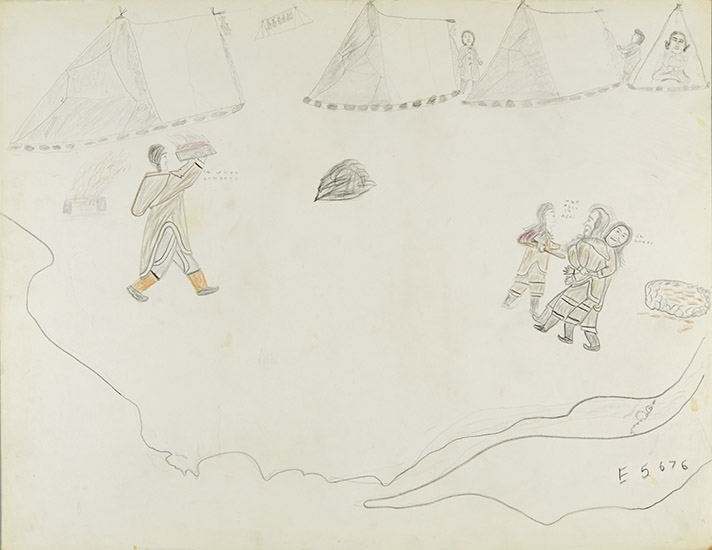
Joshua Koomangapik
Pond Inlet NU 1905–1981 Pond Inlet NU
Conflict Resolution before the RCMP
1964
Graphite on paper
Canadian Museum of History
IV-C-6703
Inscription, front and back: "This is the man's wife and she will be stabbed. Her younger sister is holding the knife. This is a story about Qayaqjuaq. Up in Pond Inlet, at the river weir, he got upset very easily."
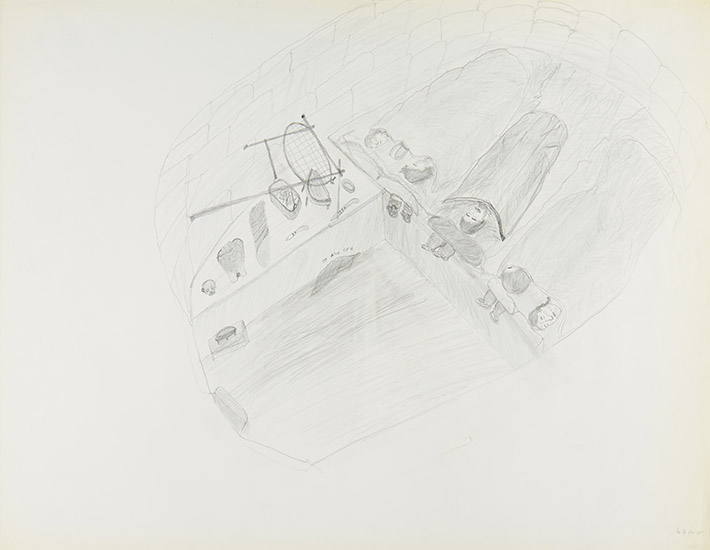
Martha Coronik Akoomalik
Pond Inlet NU 1912–2002 Pond Inlet NU
We Are Using Another Way of Life Today
1964
Graphite on paper
Canadian Museum of History
IV-C-8204
Inscription: "These people have an iglu because they are real Inuit. Their knife has a bone handle and the wife has an ulu that is not metal. The husband's knife is not metal but uluksana (stone) …they used to be very poor, real Inuit of long ago… That is what they used to do. But now they do not do that anymore. We are using another way of life today."

Enooya Enook
Pond Inlet NU 1927
Burying the Dead
1964
Graphite on paper
Canadian Museum of History
IV-C-6907
Inscription on back: "Long ago, this is how they used to bury the dead. They put their personal belongings next to their body. I'm trying to draw this based upon what I heard. People were buried with slabs of rocks to cover the body. It is how they did it a long time ago, from what I heard. "
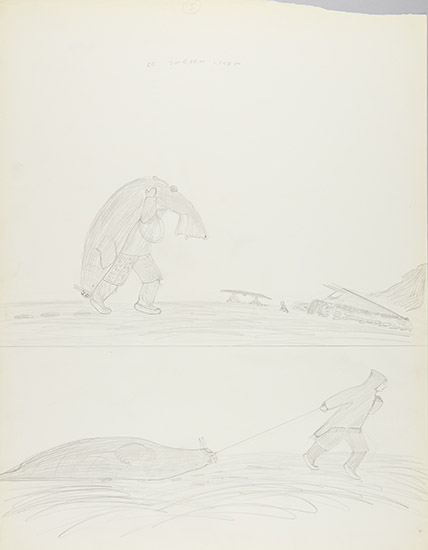
Zebedee Enoogoo
Arctic Bay NU 1931
Tuniit Carrying Walrus
1964
Graphite on paper
Canadian Museum of History
IV-C-6558
Inscription on back: "I have seen a land occupied by Tuniit (Dorset people). Their sod homes look like soil, blended in to the surrounding soil, they are really old. They say there are footprints of the Tuniit, I have seen where the land was marked, where they carried whole walruses home. They were very strong, I heard. They dragged whole walrus, even on the ground with no snow."

Solomonie Tigullaraq
Clyde River NU 1924–2000 Clyde River NU
Falling Asleep while Hunting
1964
Graphite on paper
Canadian Museum of History
IV-C-7655
Inscription: "He stayed awake for a long time, up throughout the nights. He fell asleep on his tummy, facing down. He was out seal hunting. Sometimes some Inuit can stay up for a very long time when they are hunting during springtime…Here, he fell asleep on the ground, not in the tent. He was so exhausted."
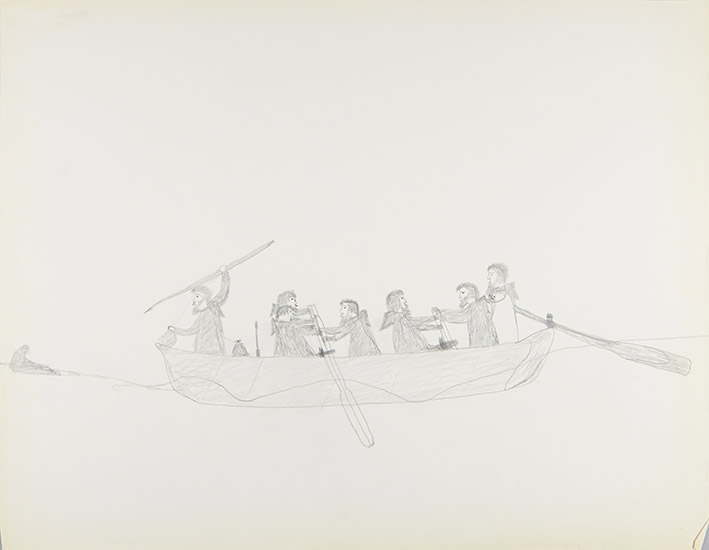
No video available
Ipeelee Shappa
Arctic Bay NU 1908–1981 Arctic Bay NU
Hunting from the Umiaq
1964
Graphite on paper
Canadian Museum of History
IV-C-6511
This is one of the few drawings without any writing on it, but it likely depicts a vivid memory of the artist, who made the drawing as an elder in 1964. With the wavy waterline and tilted boat, the artist, Ipeelee Shappa, conveys the drama, excitement and danger of hunting with a toggling harpoon from a boat, as men did before the arrival of the rifle in the twentieth century.
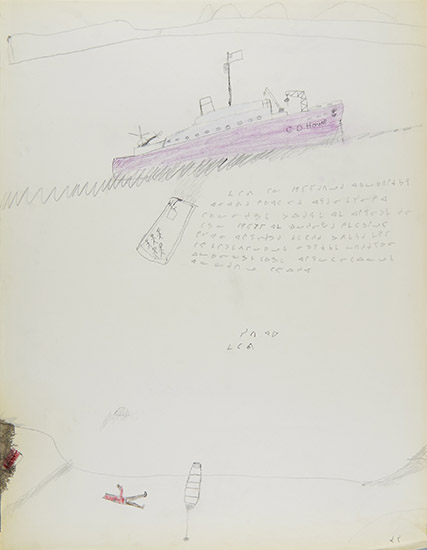
Josie Enuaraq
Clyde River NU 1942
CD Howe in the 1950s
1964
Graphite on paper
Canadian Museum of History
IV-C-8059
Inscription: "This is the C.D. Howe (Mattaaqvik) in 1955. I took this boat down south to the hospital. I was away for what felt like an eternity. Then in 1957 I started heading home, but they dropped me off in Resolute Bay then flew me down to Clyde River. I stayed in Clyde River for 2 springtimes, then when people from Nattisujuk came, I went along with them to my parents. That's the end."
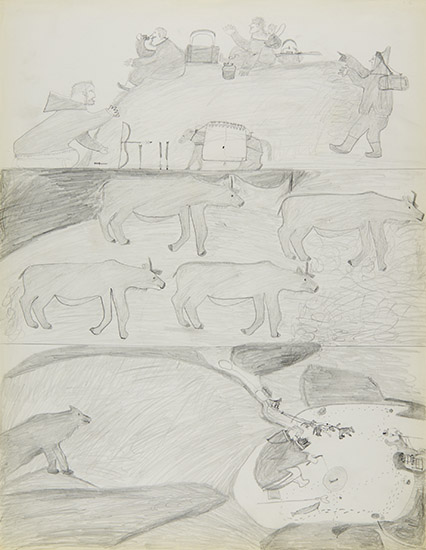
Toongalook
Arctic Bay NU 1912–1967 Arctic Bay NU
What I Had Seen a Long Time Ago
1964
Graphite on paper
Canadian Museum of History
IV-C-6848
The changes of modernity—coupled with age and generational differences—led many people to record their memories from days long ago, when times were thought to be more abundant. On the back of this drawing, this artist wrote, "I have seen this a long time ago where people had land with lots of fish."

No video available
Rebecca Koonoo
Pond Inlet NU 1892–Unknown Pond Inlet NU
The Human and Giant
1964
Graphite on paper
Canadian Museum of History
IV-C-6887
Inscription (front): "The big Indigenous person turns into a human, and wants to kill. This is a dead person [top right]. The huge man [lower left] is sleeping. Here is a man sitting on the tundra [middle right]. He is adopted by the huge man." On back: "His wife and his two children [top left] will die from starvation. The big First Nations man asked, 'how are you going to cross the river?' He is going to drink the water from the river when he gets to it."
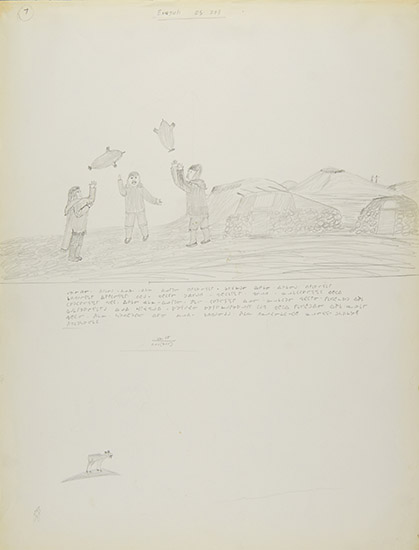
No video available
Zebedee Enoogoo
Arctic Bay NU 1931
Pretending To Be Strong for Outsiders
1964
Graphite on paper
Canadian Museum of History
IV-C-8231
Inscription: "In the old days, when non-Inuit were arriving, scary beings called Ijirait came, and Inuit would be afraid. So they would inflate their sealskin floats and toss them up in the air. When non-Inuit saw them throwing the floats up in the air, they would think Inuit were very strong because they were tossing big boulders up in the air…"
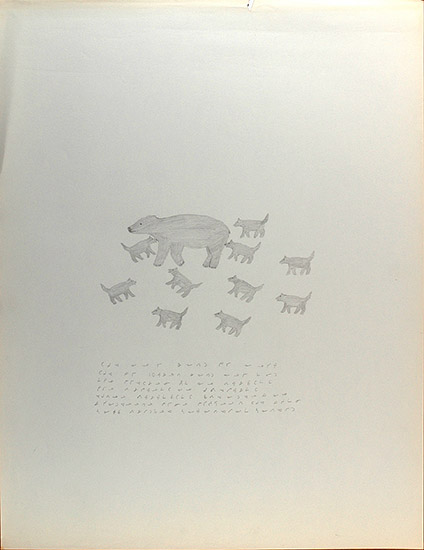
Nuqingaq Paniloo
Clyde River NU 1943
We Used Dogs to Get Bears
1964
Graphite on paper
Canadian Museum of History
IV-C-7999
Inscription: "These dogs are holding the polar bear at bay. The dogs found the bear, and there are 10 dogs…two are biting, and that is how they kill the polar bear. I just drew what was on my mind. It doesn't look attractive, I am not a very good artist."
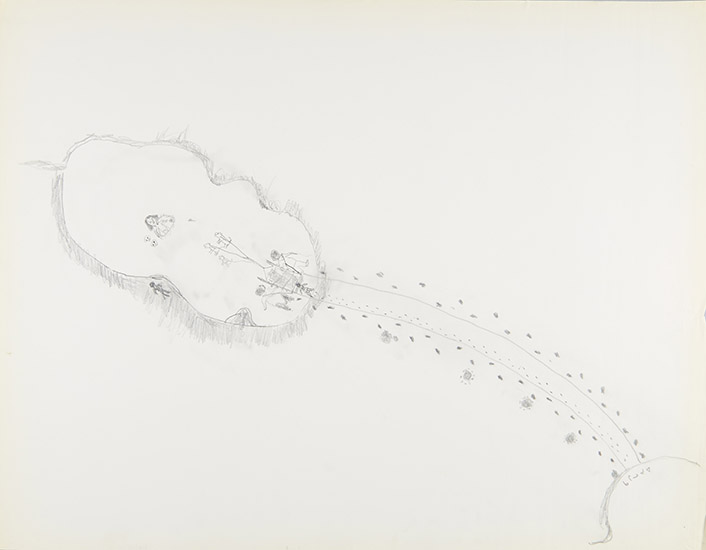
Atoat Shappa
Arctic Bay NU 1894–1976 Arctic Bay NU
Story of the Woman at the Lake
1964
Graphite on paper
Canadian Museum of History
IV-C-6508
Inscription (reverse): "I am Atoat. When I was a child, on the other side of Igloolik, we were living in a tent, on our way to cross the sea. My mother and father were pulling the sled because we had only three dogs…then I heard a sound. A person, very far away, saw us and started yelling. My father said, 'it is eating,' and I was terrified. When we reached the person, there were human skulls scattered around and the person was eating human flesh. That person was very skinny, not able to walk and was in the middle of the lake. This is my short story."

